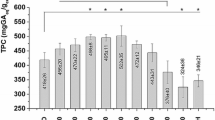Abstract
Flavonoids have recently been found in large amounts in knotwood and stemwood of several tree species. Six flavonoids, two flavonoid glucosides, and one cinnamic acid derivative were isolated from Jack pine and European aspen knotwood and structurally characterised using GC-MS, HR-MS, and NMR spectroscopic analyses. Isolated compounds were further assessed on basis of their potency to inhibit lipid peroxidation and scavenge peroxyl radicals. All tested compounds possessed antioxidant properties close to that of the reference compound Trolox.
Zusammenfassung
Im Ast- und Stammholz verschiedener Baumarten hat man in jüngerer Zeit größere Mengen von Flavonoiden gefunden. Sechs Flavonoide, zwei Flavonoidglykoside und ein Zimtsäurederivat wurden aus dem Astholz von Jack Pine und Aspe isoliert und mittels GC-MS, HR-MS und NMR Spektralanalysen strukturell bestimmt. Ausgehend von deren Potential, eine Lipidperoxidation zu hemmen und Peroxylradikale abzufangen, wurden die isolierten Verbindungen weiter untersucht. Alle untersuchten Verbindungen verfügten über antioxidative Eigenschaften, die denjenigen der Referenzverbindung Trolox weitgehend entsprachen.
Similar content being viewed by others
References
Ahotupa M, Mäntylä E, Kangas L (1997) Antioxidant properties of the triphenylethylene antiestrogen drug toremifene. Naunyn-Schmiedeberg’s Arch Pharmacol 356(3):297--302
Arjun Banskota H, Nagaoka T, Sumioka L-Y, Tezuka Y, Awale S, Midorikawa K, Matsushige K, Kadota S (2002) Antiproliferative activity of the Netherlands propolis and its active principles in cancer cell lines. J Ethnopharmacol 80(1):67--73
Bankova V, Popova M, Bogdanov S, Sabatini A-M (2002) Chemical composition of European propolis: expected and unexpected results. J Biosci 57(5/6):530--533
Holmbom B, Eckerman C, Eklund P, Hemming J, Nisula L, Reunanen M, Sjöholm R, Sundberg A, Sundberg K, Willför S (2004) Knots in trees -- a new rich source of lignans. Phytochem Rev 2(3):331--340
Hopia AI, Heinonen M (1999) Antioxidant activity of flavonol aglycones and their glycosides in methyl linoleate. J Am Oil Chem Soc 76(1):139--144
Jung HA, Jung ME, Kim JY, Chung HY, Choi JS (2003) Inhibitory activity of flavonoids from Prunus davidiana and other flavonoids on total ROS and hydroxyl radical generation. Arch Pharm Res 26(10):809--815
Jung JH, McLaughlin JL (1990) 13C-1H NMR long-range coupling and deuterium isotope effects of flavanones. Phytochemistry 29(4):1271--1275
Kumazawa S, Hamasaka T, Nakayama T (2003) Antioxidant activity of propolis of various geographic origins. Food Chem 84(3):329--339
Kuroyanagi M, Yamamoto Y, Fukushima S, Ueno A, Noro T, Miyase T (1982) Chemical studies on the constituents of Polygonum nodosum. Chem Pharm Bull 30(5):1602--1608
Kuroyanagi M, Noro T, Fukushima S, Aiyama R, Ikuta A, Itokawa I, Morita M (1983) Studies of constituents of seeds of Alpinia katsumadai Hayata. Chem Pharm Bull 31(5):1544--1550
Lindberg LE, Willför SM, Holmbom BR (2004) Antibacterial effects of knotwood extractives on paper mill bacteria. J Ind Microbiol Biotechnol 31(3):137--147
Obst JR (1998) Special (secondary) metabolites from wood. In: Bruce A, Palfreyman JW (eds) Forest Products Biotechnology. Taylor & Francis, London, pp 151--165
Ondrias K, Stasko A, Hromadova M, Suchy V, Nagy M (1997) Pinobanksin inhibits peroxidation of low density lipoprotein and it has electron donor properties reducing α-tocopherol radicals. Die Pharmazie 52(7):566--567
Pietarinen S (2005) Extractives in Stemwood and Knots of Acacia and Aspen Trees. Doctoral Thesis, Faculty of Chemical Engineering, Åbo Akademi University, Åbo, Finland
Pietarinen S, Willför S, Sjöholm R, Holmbom B (2005a) Bioactive phenolic substances in important tree species. Part 3. Knots and stemwood of Acacia crassicarpa and A. mangium. Holzforschung 59(1):94--101
Pietarinen SP, Willför SM, Vikström FA, Holmbom BR (2005b) Aspen knots, a rich source of flavonoids. J Wood Chem Technol, in press
Pietarinen S, Willför S, Ahotupa M, Hemming J, Holmbom B (2005c) Knotwood and bark extracts -- Strong antioxidants from waste materials. J Wood Sci, in press
Prescott AG, Stamford PJN, Wheeler G, Firmin JL (2002) In vitro properties of a recombinant flavonol synthase from Arabidopsis thaliana. Phytochemistry 60(6):589--593
Rice-Evans CA, Miller NJ, Paganga G (1996) Structure-antioxidant activity relationship of flavonoids and phenolic acids. Free Radical Biol Med 20(7):933--956
Rudloff E, Sato A (1965) Chemical composition of the heartwood extractive of Pinus banksiana and Pinus resinosa. In: Proc 1st Can Wood Chem Symp, Toronto (1963), pp 69--73
Sala A, Recio MC, Schinella GR, Mànez S, Giner RM, Cerdà-Nicolàs M, Rìos J-L (2003) Assessment of the anti-inflammatory activity and free radical scavenger activity of tiliroside. Eur J Pharmacol 461(1):53--61
Santos AC, Uyemura SA, Lopes JC, Bazon JN, Mingatto FE, Curti C (1998) Effect of naturally occurring flavonoids on lipid peroxidation and membrane permeability transition in mitochondria. Free Radical Biol Med 24(9):1455--1461
Silva AMS, Alkorta I, Elguero J, Silva VLM (2001) A 13C NMR study of the structure of four cinnamic acids and their methyl esters. J Mol Struct 595(1-3):1--6
Velikova M, Bankova V, Sorkun K, Houcine S, Tsvetkova I, Kujumgiev A (2000) Propolis from the Mediterranean region: chemical composition and antimicrobial activity. J Biosci 55(9/10):790--193
Willför SM, Ahotupa MO, Hemming JE, Reunanen MHT, Eklund PC, Sjöholm RE, Eckerman CSE, Pohjamo SP, Holmbom BR (2003) Antioxidative activity of knotwood extractives and phenolic compounds of selected tree species. J Agric Food Chem 51(26):7600--7606
Willför SM, Nisula L, Hemming JE, Reunanen MHT, Holmbom BR (2004) Bioactive phenolic substances in industrially important tree species. Part 1: Knots and stemwood of different spruce species. Holzforschung 58(4):335--344
Zheng W, Wang SY (2001) Antioxidative capacity and phenolic compounds in selected herbs. J Agric Food Chem 49(11):5165--5170
Author information
Authors and Affiliations
Corresponding author
Rights and permissions
About this article
Cite this article
Neacsu, M., Eklund, P.C., Sjöholm, R.E. et al. Antioxidant flavonoids from knotwood of Jack pine and European aspen . Holz Roh Werkst 65, 1–6 (2007). https://doi.org/10.1007/s00107-006-0121-0
Published:
Issue Date:
DOI: https://doi.org/10.1007/s00107-006-0121-0




